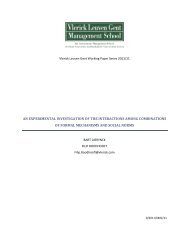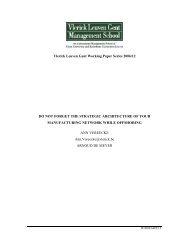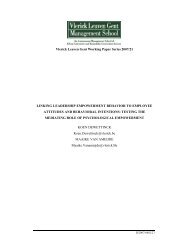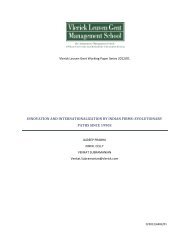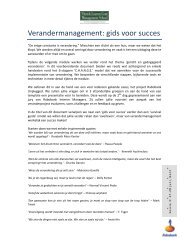Vlerick Leuven Gent Working Paper Series 2007/03 ... - Vlerick Public
Vlerick Leuven Gent Working Paper Series 2007/03 ... - Vlerick Public
Vlerick Leuven Gent Working Paper Series 2007/03 ... - Vlerick Public
You also want an ePaper? Increase the reach of your titles
YUMPU automatically turns print PDFs into web optimized ePapers that Google loves.
At the same time, the need for inquiry into intervening processes is strengthened by<br />
studies that have demonstrated superior explanatory power by including process variables in<br />
TMT research (Petterson et al., 20<strong>03</strong>; Papadakis and Barwise, 2002; Amazon and Sapienza<br />
,1997; Amazon 1996; Smith et. al.; 1994). In this respect, TMT research and research on<br />
group effectiveness in general, offer an interesting starting point to explore the added-value of<br />
including process variables in board research. Still, it can be argued that the board of directors<br />
differs from other organizational teams.<br />
Differentiating board of directors from other organizational teams<br />
The board of directors can be considered as a multi-member governing body, standing<br />
at the apex of the organization (Bainbridge, 2002). However, being a collection of individuals,<br />
boards of directors show some distinctive features which make them, to some extent, unique<br />
among organizational teams (see Appendix 1 for a summary). A first feature is partial<br />
affiliation. Board of directors usually include outside directors who are not employees of the<br />
company and do not assume management tasks. In most cases, outside directors sit on several<br />
boards and these mandates come on top of their regular ‘day job’. In this respect, outside<br />
board members are only partial affiliated to the company on whose board they serve (Forbes<br />
and Milliken, 1999; Nadler et.al., 2006). Second, boards of directors are characterised by<br />
episodic interactions. Most board of directors only meet a few times a year. Although (some)<br />
board committees meet more frequently, the meetings involve only a small subset of the<br />
whole board. By consequence, board members spend only a limited time together in the<br />
boardroom so that it’s quite difficult to experience intense personal contact. Besides, without<br />
little or no contact between formal board meetings, there is little opportunity to build strong<br />
working relationships (Forbes and Milliken, 1999; Nadler et.al., 2006). A third feature is<br />
limited time and information. Outside board members devote only limited amount of their<br />
time on board-related work (Lorsh and MacIver, 1989). Moreover, they heavily dependent on<br />
the goodwill of management to obtain relevant and timely information. In this respect, it is<br />
obvious, that outside directors - compared to executive directors- are restricted in their ability<br />
to become deeply familiar with the company, its people and its business (Nadler et.al., 2006).<br />
Fourth, boards of directors are commonly composed of a preponderance of leaders.<br />
Regarding the background of outside directors, most of them can present a track-record as<br />
former or present CEO (Forbes and Milliken, 1999).<br />
8



